Progress Update
Tortoises installed, feeders being added.
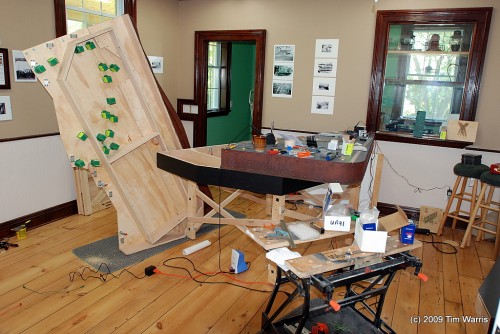
On the left is one half of the layout with all the switch machines installed. Its amazing how much of a mess gets made installing a few switch machines. The right side of the layout is also complete. 28 in total. There are two more to add, one under a turnout I still have to build, and one on the float bridge I still have to build.
I think I have set a SMDL (switch machine density level) record, 17 machines in about 3 square feet.
Nothing important about this picture, just showing a mess.
I cobbled together some feeders and took an engine for a short spin on what sections of track I would get operable. It was very thrilling. Neither of these engines belong on the terminal, they are all I have on hand at the moment.
This nifty little unit is going to same me a ton of time and headaches. What it does is take over the switching of the frog polarity on complex track. A single feeder is run to an isolated frog and the board is connected to the track feeders. When a train comes in contact with the frog, it will switch the frog polarity to the correct direction, instantly. Using this really helps with crossings, which can be difficult to control when using switch machines, especially the kind of crossings I am using. With this, I simply run a feeder to the frogs in the crossing. One unit will operate 6 frogs.
Its called a Hex Frog Juicer, by Tam Valley Railway.
When I have it operating I will post a video of it. Would be great for anyone using ground throws.
I made a road trip to lay in some supplies. Starting with some wire for feeders. Shown here is some 22GA solid wire for the frogs and track feeders. Also some 2 conductor 22GA wire for switch machine power.
I also paid a visit to Bob Scott at Credit Valley Railway and picked up a DT400IR throttle and receiver. Grabbed a power supply for the DCC system while I was there as well.
The initial plan for the layout was to use stationary decoders to control the switch machines. After a bit of thought I decided to go with simple toggle switches and control panels instead to keep it simple. After more thought, I went back to the original idea of using stationary decoders. I really didn’t design the layout for control panels, and adding them in now would be a hack. After playing with the DT400 a bit it seems that is will work well enough to operate the layout using it with stationary decoders.
I have been asked why I didn’t just use simple ground throws. The answer is easy, they are damn ugly. Also, reaching into the layout to operate them is hazardous. Although I am considering Sergent Couplers for the cars, so I am contradicting myself a bit. If there was a good looking, durable ground throw with contacts for frog switching, I would have considered it, and since I don’t have time to develop one myself, I will stick to the tried and true Tortoises with DS-64 stationary decoders.
BTW, does anyone know how many routes are possible if using multiple DS-64’s for turnout control? I have asked everyone, looked online and even called Digitrax. No one seems to know, even the tech support guy at Digitrax! Am I the only person in the model railroading universe that is doing this?
Above are the 8 DS-64’s I need for the layout. Actually, I only have 5 at the moment, Bob has three more on order for me. 3 of the DS-64’s in the picture above were added in using Photoshop. Bob, if you’re reading this, I still need three more. Don’t let the picture fool you.
Today, I added all the feeders from the switch machines to the frogs. This evening, I installed the main bus line, using 12GA wire (in black and white near the bottom of the layout section. Using suitcase connectors I have started adding the feeders to the rails and also to the switch machines. One half is almost complete, will try to get the other side done tomorrow, then start with the DS-64 installations. After that, a test run!
-T.
On to Next Section…
About the Author:
I'm your host, Tim Warris, a product developer in Port Dover, Ontario. Since March of 2007 I have been documenting the construction of the former CNJ Bronx Terminal in HO scale. For my day job, I design track building tools for Fast Tracks, a small company I own and operate. Fast Tracks makes it fast and easy to hand lay your own trackwork. Stop by our website to learn more!
Posted by: Tim | 06-01-2009 | 10:06 PM
Posted in: Latest Posts | Track Construction | wiring
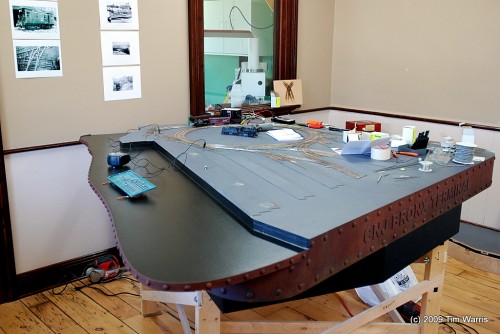
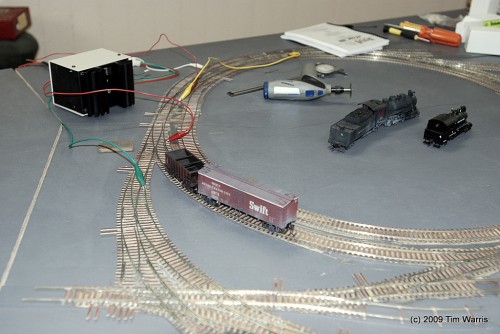
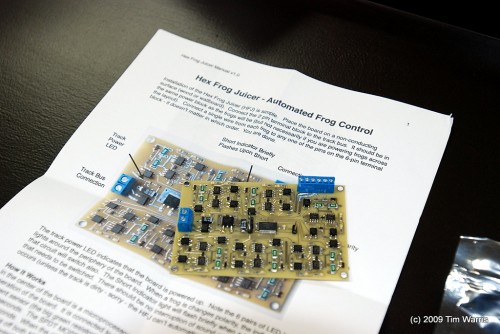
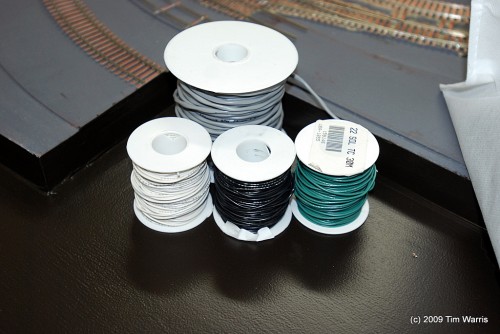
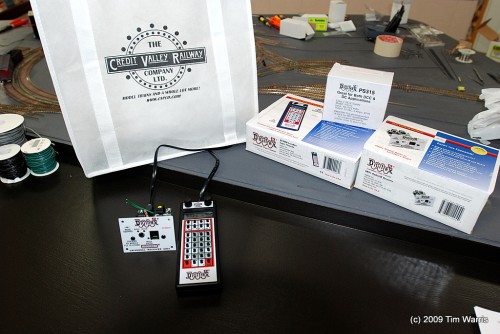
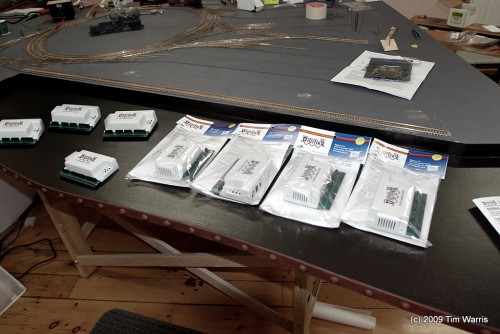
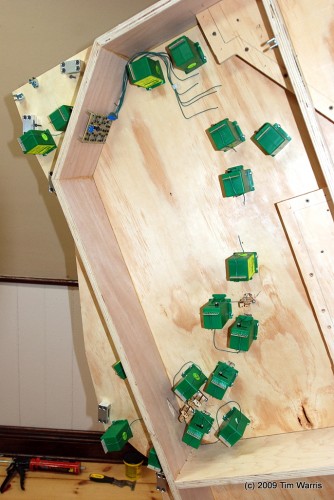
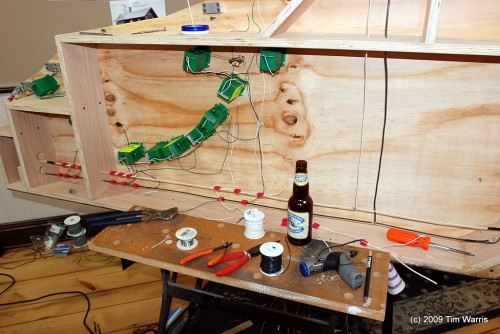
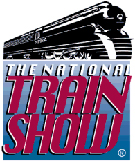
I have a TD of 12/9sq ft, which is quite high too…by the time the DS64’s and DS44’s were rigged in, the wiring count is quite high…
http://pages.pacificcoast.net/~wx732/Long%20Marton%20S&C/Models/2001-present%20model/trainsmay2009/trainsmay09.html
about midway down the page…
James
i notice u have chosen the digitrax system , thats great news becasue now i can integrate into my system very easily , i will also use RR and Co. software to control the routes and an uhlenbrock detection system to have automatic operation.
cheers
vikas
note :- i hope you also catch the hidden meaning of what i am saying above 🙂
a ds 64 canhandle 8 routes , a route can have 8 switches though u can have more switches in a route by using virtual routes , page 17 of the manual is pretty clear on how to do this. on my modular layout i number each track and zone for controlling routes so lets say i throw swich # 124
this means in zone 1 the route between track 2 and track 4 gets setup . if i throw # 356 , then in zone 3 the route between track 5 and 6 gets setup . in your layout this would be easy to setup since it is only one zone , the main circle could be track 1 and the rest of the tracks could be numbered in order of appearence depending on where u normally would stand and operate – this way you do not have to remember which switch # is for which route
Tim,
Did you consider the Blue Point Turnout Controller?
http://www.newrailmodels.com/BluePoint.htm
It’s basically a bracket that takes the place of the Tortoise; a push-rod is connected to it through the facia to a knob.
Cheers,
Colin
So those Hex Frog Juicers are kinda like auto reversing units on steroids I would guess? If I understand correctly, they eliminate the need to run wires to a set of the internal contacts in the Torts that would you would “normally” use to switch the polarity on the frog for you. Is this correct? You could use this on a double x-over too. Neat stuff, thanks for bringing to our attention.
When are too many Tortoises, not enough?
A Tortoise to far away.
If I had a Tortoise for every time someone told me where to go…
Around & around it goes. Where it stops only the Tortoises know.
I’m gonna take a Switch to that Tortoise.
By applying current to the Tortoises, they can be Trained to Switch direction…..mu-ha-ha-ha, mu-ha-ha-ha [evil laugh]
But how do we get home? Just follow the green Tortoise road.
The last time I saw this many Tortoises, was on a Bugs Bunny cartoon.
CNJ Bronx Terminator III – the rise of the Tortoises.
Hi Tim,
Am at the same stage as you with my layout. Have finished building all of my turnouts and am abut to start wiring. Your wiring job looks impeccable! Do you know of a good resouce for track and switch machine wiring that is easily available. I am a neophyte and this is the bit that scares me!
Cheers,
Steve
Tim,
A much better looking and operating ground throw is the Bitter Creek B-4001. They actually look like a lot of the low ground throws, they are metal and have multiple means of throwing the turnouts. Jeff Stone at Bitter Creek has these back on the market, see his website, shown above. I think you will find much better looking, sturdier, and a joy to use.
Tom VW
Monument CO